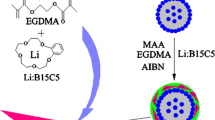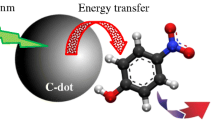Abstract
Quantum dots have been applied in sensing with success, but their use in environmental applications has been questioned due to their heavy metal content. Carbon dots are fluorescent nanoparticles that offer a promising alternative to quantum dots for sensing, due to their low cost, benign fabrication process and negligible environmental impact. Fluorescence sensors are specially suited for detection of nitroaromatic compounds such as 2,4,6-trinitrotoluene (TNT) and 2,4-dinitrotoluene (DNT), since they can quench the emission of excited species. When combined to Molecularly Imprinted Polymers (MIPs), the sensors become specific to the imprinted target molecules. Amino-functionalized carbon dots (CDs) with high photoluminescence were fabricated. The CDs were characterized with respect to their surface charge, surface chemistry, particle size distribution, and photoluminescence properties (PL). A molecularly imprinted polymer with template of DNT was combined with fluorescent carbon dots via a simple covalent reaction. The ability of aqueous DNT to quench amino CDs fluorescence was tested for concentrations in the range of 1mM to 50 mM. It can be concluded that the amino carbon dots can be used in fluorescent-labeled MIP systems and that they provide a feasible method for the detection of DNT, and potentially other nitroaromatic compounds, in environmental water samples.
Similar content being viewed by others
References
J.V. Goodpaster, V.L. McGuffin, Analytical Chemistry 73, 2004–2011 (2001).
Y. Salinas, R. Martínez-Máñez, M.D. Marcos, F. Sancenón, A.M. Costero, M. Parra, S. Gil, Chemical Society Reviews 41, 1261–1296 (2012).
R.C. Stringer, S. Gangopadhyay, S.A. Grant, Analytical Chemistry 82, 4015–4019 (2010).
K. Zhang, H. Zhou, Q. Mei, S. Wang, G. Guan, R. Liu, J. Zhang, Z. Zhang, Journal of the American Chemical Society 133, 8424–8427 (2011).
A. McCluskey, C.I. Holdsworth, M.C. Bowyer, Organic & Biomolecular Chemistry 5, 3233–3244 (2007).
G. Wulff, Chemical Reviews 102, 1–28 (2001).
S.N. Baker, G.A. Baker, Angewandte Chemie International Edition 49, 6726–6744 (2010).
Y. Wang, P. Anilkumar, L. Cao, J.-H. Liu, P. Luo, K. Tackett II, S. Sahu, P. Wang, X. Wang, Y.-P. Sun, Experimental Biology and Medicine 236, 1231–1238 (2011).
J. Shen, Y. Zhu, X. Yang, C. Li, Chemical Communications 48, 3686–3699 (2012).
X. Wang, K. Qu, B. Xu, J. Ren, X. Qu, Journal of Materials Chemistry 21, 2445–2450 (2011).
P.-C. Hsu, Z.-Y. Shih, C.-H. Lee, H.-T. Chang, Green Chemistry 14, 917–920 (2012).
W. Stöber, A. Fink, E. Bohn, Journal of colloid and interface science 26, 62–69 (1968).
P. Jiang, J. Bertone, K. Hwang, V. Colvin, Chemistry of Materials 11, 2132–2140 (1999).
M. Zheng, S. Liu, J. Li, D. Qu, H. Zhao, X. Guan, X. Hu, Z. Xie, X. Jing, Z. Sun, Advanced Materials 26, 3554–3560 (2014).
K. Hola, A.B. Bourlinos, O. Kozak, K. Berka, K.M. Siskova, M. Havrdova, J. Tucek, K. Safarova, M. Otyepka, E.P. Giannelis, R. Zboril, Carbon 70, 279–286 (2014).
P.C. Hsu, H.T. Chang, Chem Commun (Camb) 48, 3984–3986 (2012).
W. Kwon, S. Do, J.H. Kim, M. Seok Jeong, S.W. Rhee, Sci Rep 5, 12604 (2015).
Author information
Authors and Affiliations
Rights and permissions
About this article
Cite this article
Dai, J., Zambrana, M. & Fidalgo, M. Amino-functionalized Fluorescent Carbon Dots for Chemical Sensing. MRS Advances 1, 1365–1370 (2016). https://doi.org/10.1557/adv.2016.169
Published:
Issue Date:
DOI: https://doi.org/10.1557/adv.2016.169




